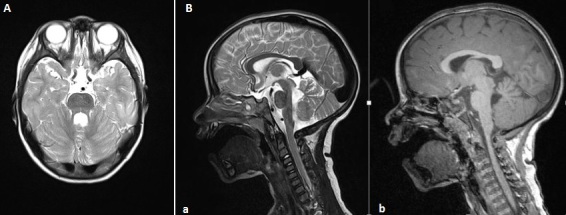Joubert syndrome
(Redirected from Joubert syndrome bilateral chorioretinal coloboma)
Editor-In-Chief: Prab R Tumpati, MD
Obesity, Sleep & Internal medicine
Founder, WikiMD Wellnesspedia &
W8MD medical weight loss NYC and sleep center NYC
| Joubert syndrome | |
|---|---|

| |
| Synonyms | N/A |
| Pronounce | N/A |
| Specialty | N/A |
| Symptoms | Hypotonia, ataxia, developmental delay, abnormal eye movements, breathing abnormalities |
| Complications | N/A |
| Onset | Infancy |
| Duration | Lifelong |
| Types | N/A |
| Causes | Genetic mutation |
| Risks | Family history |
| Diagnosis | Clinical examination, MRI, genetic testing |
| Differential diagnosis | Dandy-Walker malformation, cerebellar hypoplasia |
| Prevention | N/A |
| Treatment | Supportive care, physical therapy, occupational therapy, speech therapy |
| Medication | N/A |
| Prognosis | Variable, depends on severity and associated features |
| Frequency | 1 in 80,000 to 1 in 100,000 |
| Deaths | Rare, depends on severity and complications |
Joubert syndrome is a rare genetic disorder characterized by the underdevelopment of the cerebellar vermis, a part of the brain that controls balance and coordination. This condition is part of a group of disorders known as ciliopathies, which are caused by defects in the function of cellular structures called cilia.
Signs and Symptoms[edit | edit source]
Individuals with Joubert syndrome typically present with a range of symptoms, including:
- Hypotonia (low muscle tone)
- Ataxia (lack of muscle coordination)
- Developmental delays
- Abnormal eye movements, such as nystagmus
- Breathing abnormalities, including episodes of rapid breathing (hyperpnea) and apnea
Genetics[edit | edit source]
Joubert syndrome is genetically heterogeneous, meaning it can be caused by mutations in several different genes. Some of the genes associated with Joubert syndrome include:
These genes are involved in the function and structure of cilia, which are essential for various cellular processes.
Diagnosis[edit | edit source]
The diagnosis of Joubert syndrome is based on clinical features and neuroimaging findings. A key diagnostic feature is the "molar tooth sign" observed on MRI scans, which results from the abnormal development of the cerebellar vermis and brainstem.
Management[edit | edit source]
There is no cure for Joubert syndrome, and treatment is primarily supportive and symptomatic. Management strategies may include:
- Physical therapy to improve motor skills and coordination
- Occupational therapy to assist with daily activities
- Speech therapy to address communication difficulties
- Regular monitoring and management of breathing abnormalities
Prognosis[edit | edit source]
The prognosis for individuals with Joubert syndrome varies widely depending on the severity of symptoms and the presence of associated conditions. Some individuals may have mild symptoms and lead relatively normal lives, while others may have significant developmental and physical challenges.
See also[edit | edit source]
External Links[edit | edit source]
| Diseases of cilia | ||||||
|---|---|---|---|---|---|---|
See also: ciliary proteins
|
| Deficiencies of intracellular signaling peptides and proteins | ||||||||||||
|---|---|---|---|---|---|---|---|---|---|---|---|---|
|
Transform your life with W8MD's budget GLP1 injections from $125
W8MD offers a medical weight loss program NYC and a clinic to lose weight in Philadelphia. Our W8MD's physician supervised medical weight loss centers in NYC provides expert medical guidance, and offers telemedicine options for convenience.
Why choose W8MD?
- Comprehensive care with FDA-approved weight loss medications including:
- loss injections in NYC both generic and brand names:
- weight loss medications including Phentermine, Qsymia, Diethylpropion etc.
- Accept most insurances for visits or discounted self pay cost.
- Generic weight loss injections starting from just $125.00 for the starting dose
- In person weight loss NYC and telemedicine medical weight loss options in New York city available
- Budget GLP1 weight loss injections in NYC starting from $125.00 biweekly with insurance!
Book Your Appointment
Start your NYC weight loss journey today at our NYC medical weight loss, and Philadelphia medical weight loss Call (718)946-5500 for NY and 215 676 2334 for PA
Search WikiMD
Ad.Tired of being Overweight? Try W8MD's NYC physician weight loss.
Semaglutide (Ozempic / Wegovy and Tirzepatide (Mounjaro / Zepbound) available. Call 718 946 5500.
Advertise on WikiMD
|
WikiMD's Wellness Encyclopedia |
| Let Food Be Thy Medicine Medicine Thy Food - Hippocrates |
Translate this page: - East Asian
中文,
日本,
한국어,
South Asian
हिन्दी,
தமிழ்,
తెలుగు,
Urdu,
ಕನ್ನಡ,
Southeast Asian
Indonesian,
Vietnamese,
Thai,
မြန်မာဘာသာ,
বাংলা
European
español,
Deutsch,
français,
Greek,
português do Brasil,
polski,
română,
русский,
Nederlands,
norsk,
svenska,
suomi,
Italian
Middle Eastern & African
عربى,
Turkish,
Persian,
Hebrew,
Afrikaans,
isiZulu,
Kiswahili,
Other
Bulgarian,
Hungarian,
Czech,
Swedish,
മലയാളം,
मराठी,
ਪੰਜਾਬੀ,
ગુજરાતી,
Portuguese,
Ukrainian
Medical Disclaimer: WikiMD is not a substitute for professional medical advice. The information on WikiMD is provided as an information resource only, may be incorrect, outdated or misleading, and is not to be used or relied on for any diagnostic or treatment purposes. Please consult your health care provider before making any healthcare decisions or for guidance about a specific medical condition. WikiMD expressly disclaims responsibility, and shall have no liability, for any damages, loss, injury, or liability whatsoever suffered as a result of your reliance on the information contained in this site. By visiting this site you agree to the foregoing terms and conditions, which may from time to time be changed or supplemented by WikiMD. If you do not agree to the foregoing terms and conditions, you should not enter or use this site. See full disclaimer.
Credits:Most images are courtesy of Wikimedia commons, and templates, categories Wikipedia, licensed under CC BY SA or similar.
Contributors: Prab R. Tumpati, MD



